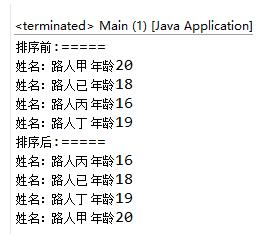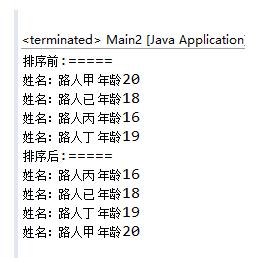方法一:实现comparator接口,并重写compare方法
实体类代码:
|
1
2
3
4
5
6
7
8
9
10
11
12
13
14
15
16
17
18
19
20
21
22
23
24
25
26
27
28
29
30
31
32
33
34
35
36
37
38
39
40
41
42
43
44
|
import java.util.comparator;/** * 学生类 方法一 * 实现comparator接口 * 并重写compare方法 * @author liaot * */public class student implements comparator<student>{ private string name; //姓名 private int age; //年龄 //重写 比较方法 本次例子定义为按年龄比较 @override public int compare(student o1, student o2) { if(o1.getage() > o2.getage()){ return 1; }else{ return -1; } } public student(string name, int age) { super(); this.name = name; this.age = age; } public string getname() { return name; } public void setname(string name) { this.name = name; } public int getage() { return age; } public void setage(int age) { this.age = age; }} |
测试类:
|
1
2
3
4
5
6
7
8
9
10
11
12
13
14
15
16
17
18
19
20
21
22
23
24
25
26
27
28
29
30
31
|
import java.util.arraylist;import java.util.collections;import java.util.list;public class main { public static void main(string[] args) { //初始化四个不同的学生 student stu1 = new student("路人甲", 20); student stu2 = new student("路人已", 18); student stu3 = new student("路人丙", 16); student stu4 = new student("路人丁", 19); //新建list把学生加进list list<student> stulist = new arraylist<>(); stulist.add(stu1); stulist.add(stu2); stulist.add(stu3); stulist.add(stu4); system.out.println("排序前:====="); for(student stu :stulist){ system.out.println("姓名:"+stu.getname() +" 年龄"+stu.getage()); } //排序 collections.sort(stulist, stu1); //第一个参数为list 第二个参数为对象的一个实例 system.out.println("排序后:====="); for(student stu :stulist){ system.out.println("姓名:"+stu.getname() +" 年龄"+stu.getage()); } }} |
运行结果:

方法二:实现comparable接口 并重写compareto方法
|
1
2
3
4
5
6
7
8
9
10
11
12
13
14
15
16
17
18
19
20
21
22
23
24
25
26
27
28
29
30
31
32
33
34
35
36
37
38
39
40
41
42
43
|
/** * 学生类 方法二 实现comparable接口 并重写compareto方法 * * @author liaot * */public class student2 implements comparable<student2> { private string name; // 姓名 private int age; // 年龄 // 重写 比较方法 本次例子定义为按年龄比较 @override public int compareto(student2 stu) { if (this.age > stu.getage()) { return 1; } else { return -1; } } public student2(string name, int age) { super(); this.name = name; this.age = age; } public string getname() { return name; } public void setname(string name) { this.name = name; } public int getage() { return age; } public void setage(int age) { this.age = age; }} |
测试类
|
1
2
3
4
5
6
7
8
9
10
11
12
13
14
15
16
17
18
19
20
21
22
23
24
25
26
27
28
29
30
31
|
import java.util.arraylist;import java.util.collections;import java.util.list;public class main2 { public static void main(string[] args) { //初始化四个不同的学生 student2 stu1 = new student2("路人甲", 20); student2 stu2 = new student2("路人已", 18); student2 stu3 = new student2("路人丙", 16); student2 stu4 = new student2("路人丁", 19); //新建list把学生加进list list<student2> stulist = new arraylist<>(); stulist.add(stu1); stulist.add(stu2); stulist.add(stu3); stulist.add(stu4); system.out.println("排序前:====="); for(student2 stu :stulist){ system.out.println("姓名:"+stu.getname() +" 年龄"+stu.getage()); } //排序 collections.sort(stulist); //只有一个参数参数为list system.out.println("排序后:====="); for(student2 stu :stulist){ system.out.println("姓名:"+stu.getname() +" 年龄"+stu.getage()); } }} |
运行结果

三、总结:两种方式写法和用法上的区别:

以上这篇java根据list内对象的属性排序方法就是小编分享给大家的全部内容了,希望能给大家一个参考,也希望大家多多支持服务器之家。
原文链接:http://blog.csdn.net/c1481118216/article/details/53496083













